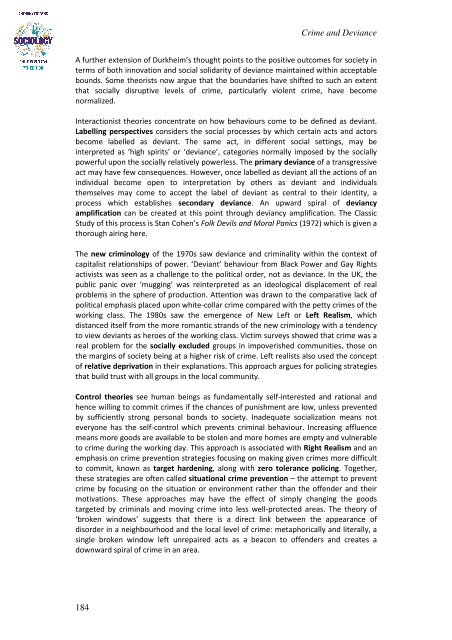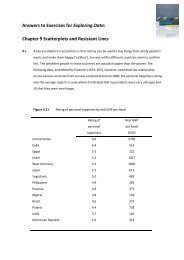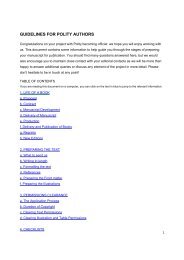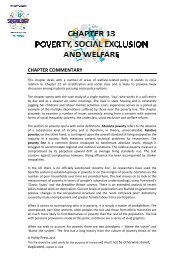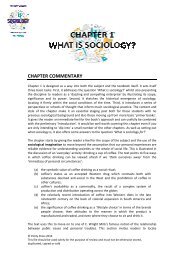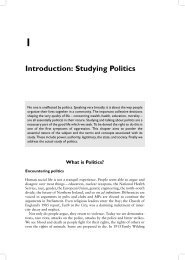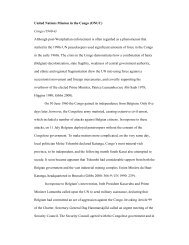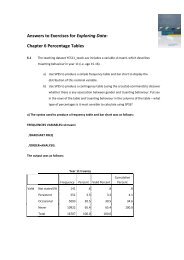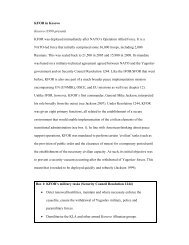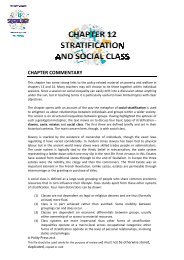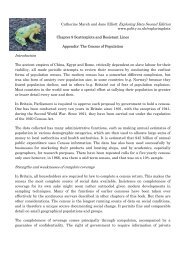Chapter 21 - Crime and Deviance - Polity
Chapter 21 - Crime and Deviance - Polity
Chapter 21 - Crime and Deviance - Polity
You also want an ePaper? Increase the reach of your titles
YUMPU automatically turns print PDFs into web optimized ePapers that Google loves.
<strong>Crime</strong> <strong>and</strong> <strong>Deviance</strong><br />
A further extension of Durkheim’s thought points to the positive outcomes for society in<br />
terms of both innovation <strong>and</strong> social solidarity of deviance maintained within acceptable<br />
bounds. Some theorists now argue that the boundaries have shifted to such an extent<br />
that socially disruptive levels of crime, particularly violent crime, have become<br />
normalized.<br />
Interactionist theories concentrate on how behaviours come to be defined as deviant.<br />
Labelling perspectives considers the social processes by which certain acts <strong>and</strong> actors<br />
become labelled as deviant. The same act, in different social settings, may be<br />
interpreted as ‘high spirits’ or ‘deviance’, categories normally imposed by the socially<br />
powerful upon the socially relatively powerless. The primary deviance of a transgressive<br />
act may have few consequences. However, once labelled as deviant all the actions of an<br />
individual become open to interpretation by others as deviant <strong>and</strong> individuals<br />
themselves may come to accept the label of deviant as central to their identity, a<br />
process which establishes secondary deviance. An upward spiral of deviancy<br />
amplification can be created at this point through deviancy amplification. The Classic<br />
Study of this process is Stan Cohen’s Folk Devils <strong>and</strong> Moral Panics (1972) which is given a<br />
thorough airing here.<br />
The new criminology of the 1970s saw deviance <strong>and</strong> criminality within the context of<br />
capitalist relationships of power. ‘Deviant’ behaviour from Black Power <strong>and</strong> Gay Rights<br />
activists was seen as a challenge to the political order, not as deviance. In the UK, the<br />
public panic over ‘mugging’ was reinterpreted as an ideological displacement of real<br />
problems in the sphere of production. Attention was drawn to the comparative lack of<br />
political emphasis placed upon white-collar crime compared with the petty crimes of the<br />
working class. The 1980s saw the emergence of New Left or Left Realism, which<br />
distanced itself from the more romantic str<strong>and</strong>s of the new criminology with a tendency<br />
to view deviants as heroes of the working class. Victim surveys showed that crime was a<br />
real problem for the socially excluded groups in impoverished communities, those on<br />
the margins of society being at a higher risk of crime. Left realists also used the concept<br />
of relative deprivation in their explanations. This approach argues for policing strategies<br />
that build trust with all groups in the local community.<br />
Control theories see human beings as fundamentally self-interested <strong>and</strong> rational <strong>and</strong><br />
hence willing to commit crimes if the chances of punishment are low, unless prevented<br />
by sufficiently strong personal bonds to society. Inadequate socialization means not<br />
everyone has the self-control which prevents criminal behaviour. Increasing affluence<br />
means more goods are available to be stolen <strong>and</strong> more homes are empty <strong>and</strong> vulnerable<br />
to crime during the working day. This approach is associated with Right Realism <strong>and</strong> an<br />
emphasis on crime prevention strategies focusing on making given crimes more difficult<br />
to commit, known as target hardening, along with zero tolerance policing. Together,<br />
these strategies are often called situational crime prevention – the attempt to prevent<br />
crime by focusing on the situation or environment rather than the offender <strong>and</strong> their<br />
motivations. These approaches may have the effect of simply changing the goods<br />
targeted by criminals <strong>and</strong> moving crime into less well-protected areas. The theory of<br />
‘broken windows’ suggests that there is a direct link between the appearance of<br />
disorder in a neighbourhood <strong>and</strong> the local level of crime: metaphorically <strong>and</strong> literally, a<br />
single broken window left unrepaired acts as a beacon to offenders <strong>and</strong> creates a<br />
downward spiral of crime in an area.<br />
184


